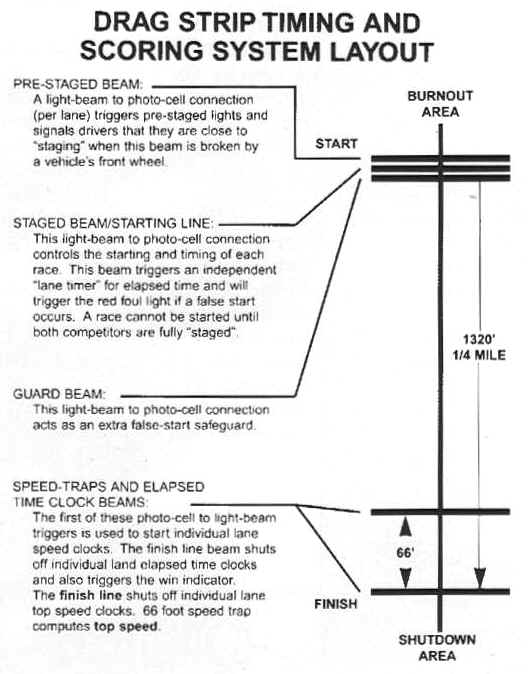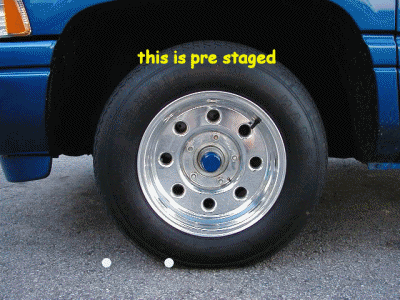Tech; Drag Racing 101
How To Drag Race
A drag race is simply an acceleration contest between two vehicles from a standing start over a measured distance, usually a quarter mile (1,320 feet) or eighth mile (660feet). A drag racing event is a group of similarly equipped vehicles running a tournament elimination contest where loser is eliminated after one loss & the winner moves on to the next round until there is only one vehicle left. These races are started with an electrical device called a Christmas Tree due to its large amber, green & red lighting sequence. On each side of the tree there are seven lights; two small amber lights at the top followed in descending order by three large amber lights, a green light, & a red light.The timing lights, or Christmas Tree are activated when the driver's front wheels break a narrow beam of light crossing the track. Once both vehicles clear the lights (two beams are broken, one for pre-stage & one for stage), the timers start & the race is under way. When the front wheels break another beam at the end of the track, the clocks are stopped & the winner is decided.Clicking below will give a description for each (back button to return)
Issues with my paint program working with Frontpage so no mouse overs for now
The Handicap & The Dial-In
To establish how much of a head start the slower car of the two will get, all cars are required to dial in. Dialing in is your best guess at what elapsed time your car will consistently cover the quarter mile. A # of practice laps or runs will establish this. Beginners should pick a time that is slower that the best practice run. Running faster than your dial in during the race is called breaking out. If both racers break out of their dial-in times, the racer who least broke out shall be declared the winner. Because the handicap is based on the difference of the dial in of both vehicles racing, running substantially slower than the dial in increases the likelihood that you will be run down by the faster car or never catch up to the slower car.
BRACKETS
Brackets are set up to make the racing more exciting by classing vehicles in different performance levels. Brackets are based on the times the cars are capable of & are usually set up on a one second performance spread. Once both cars have staged, the three amber lights will go off in sequence 1/2 second apart until it reaches the green light. A perfect bracket light is .500 though some tracks now run a .000 light as perfect (TMP switched)
![]()

Leaving The Line
Once the driver has both the pre-stage & stage lights lit, the starting official will trigger the main lights on the Christmas Tree. With 1/2 second apart, you should leave when the green comes on, right?
Wrong. If you wait for the green to come on before hitting the throttle, you will most likeyly lose the race.
Remember that it takes times for you to actually hit the gas, then time to leave the stagging beam before the clocks start. Since there is 1/2 second between the last amber & the green light, it is safe to leave just as that third amber comes on. Reaction times are important if you want to win the race. Cutting a perfect light (.500) is a good way to start a race. The amount of time between when the green light comes on & the staged light goes out is your reaction time. You want this time to be as close to 1/2 a second(.500)as possible without going under, causing a redlight. This redlight is an automatic loss of the race.
REDLIGHTING
Redlighting is an automatic loss in drag racing. Redlights occur when a driver leaves the starting line too early, prior to the green light coming on. Timing is very important, although it may be good to redlight once in a while just to see how far you can push it when it comes to leaving the line.
Running The Race
Once the green light has flashed & you are moving forward, without any traction problems (usually tire shake or tire hop), floor it & keep it floored until you pass the timing lights 1,320' down the track.
If you do have a traction problem, you may have to feather the clutch or ease off the throttle until your tires are hooked up to the track. Spinnging you tires may look & sound good, but that doesn't help you win a race. As you go down the 1/4 or 1/8 mile concentrate on making your shift points & keeping the car in the centre of your lane. If you cross the centre line, you automatically lose the race.
If you have a mechanical problem, pull over to the side or outside edge of the race track to avoid dumping oil all the way down the track.
Example
If lane one has a truck dialed in at 14.35 & lane two has a car dialed in at 12.75 then lane one has the handicap because the truck is the slower of the two lanes. The truck in lane one would have a 1.6 second head start on the car. Theoretically speaking, if both cars cut perfect lights(.500 or .000) & run their dial ins, the race would end up dead even at the finish line.

Set up for your Ram
Weight
I cant stress this one enough. If you want to go fast in a Ram put her on a diet. Empty all items from the interior as well as leave the spare and tools in the pit area. You want to get to the track with about 1/4tank of gas. For more see weight reduction page
Street tires.
I run Good Year Eagle GTIIs occasionally at the track.
When I do, I usually bump the front tires to about 3 psi over the maximum listed on tire (less rolling resistance better weight transfer). On the rear tires I would drop them by about 25% of the tires max. Mine go down to 32-33lbs from the 44lbs cold suggested by manufacturer.
On a tire as wide as the 275 or more you don't wont to go lower than that due to the tires tendency to cup reducing the contact area.
Race tires.
Mickey Thompson Sportsman 28"x7.5" bumped to about 32psi(30 max)
Rear M/T Et Street (dot slick) 28x12.5" set for 16psi even(20psi max). Testing @ lower psi spring 02
Really green, don't know what to expect or what to do once you get there? Read on,
Track Etiquette & What To Expect
When paying at the gate ask where to "tech in". A track official will look over your truck to make sure its fit to go down the track. With a street truck they may give you a quick glance or they may just send you on your way. Unless you've got a nos bottle in the bed (or a big honkin S/C) then they may give you a closer look.
After teching in, park her by the lanes. Don't line up, instead hangout by the start line and watch a few passes. Pay attention to where the racers go with instructions from the track workers (hand instructions). Also pay close attention to the line. Where they set off the pre stage and how far they have to roll to get the staged lights lit. If the line isn't clearly marked be sure to look for the box that houses the timers on both sides of the track. Notice the two holes for the pre stage and staged lights and how far they are apart. Box should be about 1'x2' and about 4-5" tall.
Beams are about 1-2 inches above the track.
Once you see what's going on head to the lanes.
At Cayuga the lanes are 12 wide with a line at the end where it goes to 2 lanes. You need to be waved on by a track official most of the times to cross the line. Test n Tune usually no lane official so it can be a free for all when lining up.
Once waved on, line up with the other cars waiting for their turn in the burnout box. I tend to hang back when next in line for the burnout box to avoid the flying debris from the car/truck ahead. I lockout od at this time and close the slider & both windows and make sure the power mirrors are pointing down so I can see the tires during my burnout. When waved into the burnout area on a treaded tire always drive around the water box. (water dripping off your tires at the line wont be appreciated by other racers) On a street tire don't bother to back into the water but just short of it . Wait for the ok from the box worker to start your burnout. No burnouts while staged cars are at the starting line. Plant the brakes firmly, put it in 1st and give it enough gas to get her spinning at about 4-5k rpms and shift to second if it spins, shift to drive and let off, coasting with brake to the start line. No long burnouts on street tires, you will only make the tire greasy. You mainly want to clean out the stones from the treads and warm it up a bit. One other thing, as a courtesy to other racers, wait to stage for the other guy. If your impatient and he takes too long pre stage ;)
Pay attention to the starter as you approach the line after your burnout in case he wants you to wait. Slowly roll forward and set off the top lights (pre stage). Inch forward (remember how far the beams were apart) slowly until you just turn on the staged lights. Having the beam at the front of the tire you will have a faster et than if you stage deep (beam @ back) by approx .1. Beams have about 8-10" of tire behind them by staging shallow so you get rolling for that distance before the timers start counting. Here's what I'm referring to. White dots at the bottom of my Sportsman tire represent the beams.

If you stage shallow with the tire at the front of the beam you will probably be leaving just as, or before the last yellow lights up. This simulates a .500 tree accurately as to how fast the lights will come down.
![]()
If your not hitting 5k at the shifts in auto then manually shift it. (be sure to lockout OD) I manually shift to make sure I get the rpms I want so the tranny doesn't short shift. Transgo StageIII shifts in auto before 4800rpm 1-2, 4600 2-3 regardless of tv adjustment. You will probably want to load the stock torque converter to about 1000-1500rpms at the line. Experiment to see what your truck likes by checking the 60' times. On the stock converter I was holding it at 12-1300rpms Depending on how good your traction is, either roll the gas on while releasing the brake at the last yellow or hit it harder if the tires hold. Spinning or squealing off the line makes you slow. No tire spin is the best. Push it till it does spin to find out how far you can push it then back off a bit next pass.
Most important, watch the officials for instructions and have FUN!

